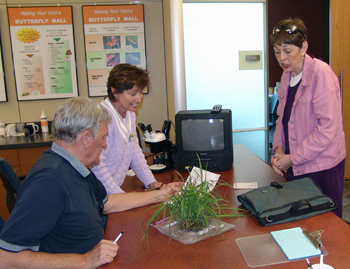Gardening Hotline
Do you have a lawn or garden question such as:
- What do I plant?
- How do I plant?
- What's eating my plant?
If so, contact the Extension Master Gardener Hotline. We are ready to help you solve your growing concerns. Whether you contact us by phone, email or in person, Extension is your source for non-biased, researched-based answers to your questions.

Diagnosing Plant Problems
The Horticulture staff and EMGs are available to assist you in identifying your lawn and garden problems.
Emailing a question
- Consider taking a picture of the plant or issue and emailing the picture with your question.
- When taking photos for emailing, make sure to use the lowest resolution setting on the camera, as they email much faster.
- Send several photos, including
- ones up close showing the damage,
- and one that shows the entire plant
- Email the photos with your question to: garden.help@jocogov.org
- Click here for more tips on how to take the best picture for diagnosis. (Thank you to our friends at Clemson Extension.)
Tips for gathering samples to bring into the Extension office for diagnosis:
Lawn Samples
- Cut a piece of sod, including the upper root and soil layer, about the size of a salad plate, or about 6” x 6".
- Try to collect your sod sample from an area that contains some healthy and dying stages.
- A dead sample will reveal little information.
- Do not just bring in a handful of grass blades as more information is needed.
- Place the sample in a plastic bag or small container for transporting.
Tree and Shrub Samples
- A 1 – 2 foot branch or twig showing the damage is the most helpful for diagnosing problems.
- Avoid a limb that is completely dead, or bringing in a handful of leaves.
- It may be helpful to collect several limbs showing the various stages of decline.
- If possible, cut just before bringing into the office.
- If they must be cut and held, keep them refrigerated to preserve freshness.
Insect Samples
- Avoid squashing the insect, if at all possible.
- Do not collect between pieces of tape.
- Instead, trap the insect in a small bottle or bag.
- If you need to kill the insect place it in a bottle containing rubbing alcohol.
Houseplants
- If possible, bring the entire plant to the office, pot and all.
- This gives us the best picture of what is going on with the plant.
- If this is not possible, a couple of small shoots are helpful.
- A leaf-only sample often does not show enough for a proper diagnosis.
The EMG Hotline is available year-round to meet all your lawn and garden needs.
So, give us a call at 913-715-7050, send us an email at garden.help@jocogov.org, or stop in and see us. We're here to help!
